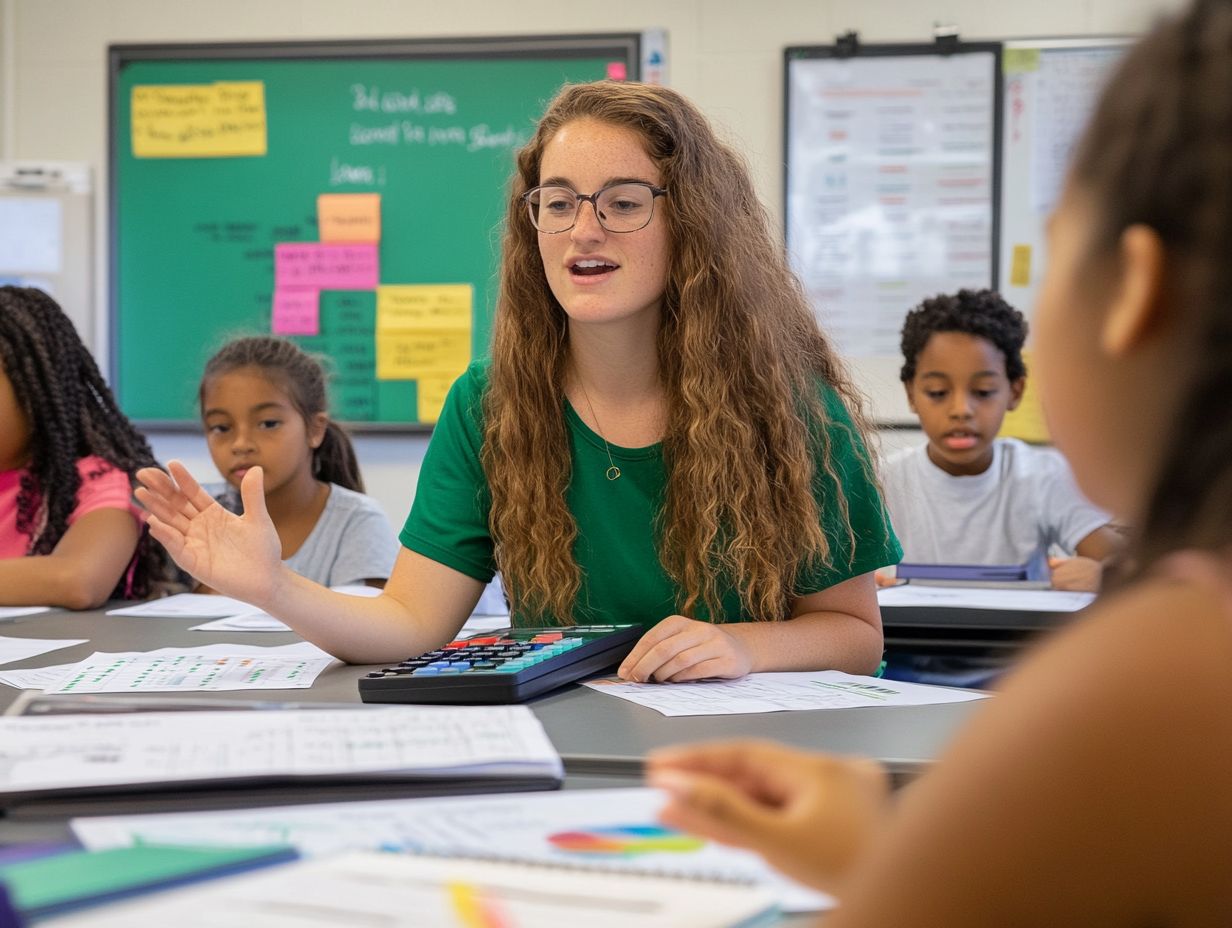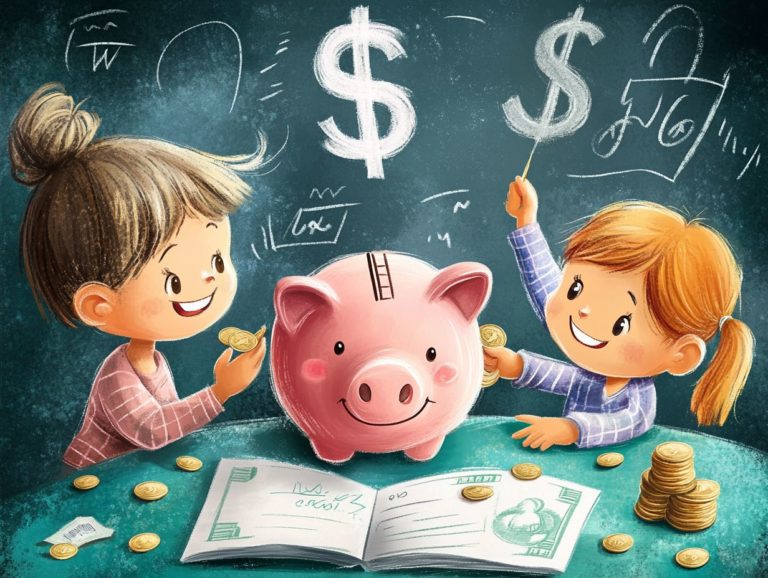How Can Schools Incorporate Financial Literacy into Their Curriculum?

Neale Godfrey is the financial voice for women and multi-generations and a world-renowned speaker and author, who has inspired millions through her work. She motivates, trains, educates, and frankly, entertains by delivering her core message: Empower yourself to take control of your financial life.
Financial literacy is an important skill that helps students manage the difficulties of personal finance, from budgeting to investing.
As the world becomes increasingly interconnected and financial decisions grow more intricate, understanding money management becomes vital for future success.
This talk looks into the significance of financial literacy in schools, offering strategies for integrating these teachings into curriculums.
Discover the benefits of financial education topics to address, and tools available to support educators in guiding students with lifelong financial skills.
Key Takeaways:
What is Financial Literacy?

Financial literacy involves managing money wisely, including setting up budgets, saving, investing, and making informed financial choices. It’s an important ability that helps individuals take charge of their finances, stay away from scams, and form responsible spending habits.
As the economy changes quickly, knowing how to manage money helps people with budgeting, learning about interest rates, controlling debt, and aiming to grow their savings. According to Experian’s insights, financial literacy is crucial in adapting to these economic shifts and empowering individuals.
Sadly, many students become adults without learning important financial skills, underscoring the need for strong financial education programs in schools from kindergarten to 12th grade. For an extensive analysis of this need, our comprehensive study on the importance of financial literacy for kids provides valuable insights.
Why is Financial Literacy Important for Students?
Teaching students about money management is important because it equips them with the basic skills needed to make wise financial decisions throughout their lives.
With growing worries about student loan debt and financial stress among U.S. adults, including financial education in K-12 school programs is necessary. This concern is echoed by the Federal Reserve’s detailed examination of the economic well-being of U.S. households, which highlights the impact of student loans on financial stability.
Educating students about money helps them understand credit card debt, learn how to budget, and build good financial habits. Additionally, implementing financial literacy assessments can effectively gauge and enhance their understanding at different age levels.
Learning about money early can have a big impact on someone’s financial stability and success later in life, making it an important part of a complete education.
What are the Benefits of Teaching Financial Literacy in Schools?
Teaching financial literacy in schools offers many benefits that go beyond the classroom. It provides students with necessary skills for managing personal finances and helps develop a generation confident in handling financial matters.
- By including lessons about money management in the K-12 education system, students learn important money skills like creating a budget, handling debt, and the importance of planning finances.
This involvement with financial literacy programs helps students develop good money habits and motivates them to manage their finances actively.
As they gain more skill in handling financial evaluations, they become much more confident in dealing with daily costs and investments.
This basic knowledge helps young people make wise financial decisions, avoid debt issues, and support a stable and expanding economy.
How Can Schools Add Financial Literacy to Their Curriculum?
Schools can teach students about handling money by using creative techniques that strengthen their financial knowledge and skills. By including financial topics in existing subjects, offering special courses, and collaborating with banks or financial organizations, teachers can provide a thorough financial education.
Using technology and practical tools can make learning about money more interesting for students, allowing them to understand its relevance in real-life situations. This varied method helps improve the financial education program and gets students ready to make money decisions later (our guide to financial literacy apps offers practical insights for educators).
1. Integrate Financial Literacy into Existing Subjects

Integrating financial literacy into existing subjects is a pragmatic approach that allows educators to teach essential financial concepts without overhauling the entire curriculum. When students study financial topics in classes like mathematics, social studies, and economics, they see how financial knowledge is useful for daily activities and career opportunities.
For example, math lessons can include budgeting exercises, while social studies can talk about how financial decisions affect economic growth. This approach helps students learn how to manage money well and encourages them to think broadly about learning.
Teachers can use real-world examples in science lessons by discussing the economics of renewable energy sources, asking students to examine the costs and benefits.
In language arts, students might work on writing tasks that involve evaluating financial products or composing persuasive essays on why saving money is important.
By teaching these elements of financial education in the curriculum, students learn to think carefully and gain essential knowledge to help them make wise financial choices.
This alignment improves education, getting students ready for the challenges of today’s finance world.
2. Create a Standalone Course
Creating an independent financial literacy class ensures all students gain knowledge about money, regardless of their other subjects. This course shows you how to manage a budget, learn about credit and debt, and why saving money is important. It includes information on 529 plans and Roth IRAs.
By using a simple method to learn about personal finance, students can gain useful skills to handle their money well for their entire lives. This course can also address financial literacy challenges students face and give solutions to overcome them.
Besides the basic ideas, the course might cover subjects like the basics of investing, tax effects, and how economic shifts affect personal money matters.
Using methods like hands-on workshops, actual case studies, and group projects can improve learning and memory. By teaching students to think carefully and act responsibly with money, this educational program can greatly improve their ability to understand and manage financial matters.
People who are interested in technology might find online tools and budgeting apps helpful for managing their money effectively, creating a solid foundation for making wise financial decisions over time.
3. Partner with Financial Institutions or Organizations
Working together with banks and local groups helps schools improve their financial literacy programs and gives students practical knowledge. Working with groups such as the American Public Education Foundation, Visa, or Junior Achievement can provide helpful resources, knowledge, and engaging activities for students in the classroom.
These partnerships can help organize sessions on financial topics, talks by experts, and practical exercises. This allows students to gain knowledge on handling debt, learning about interest rates, and steering clear of financial fraud directly from industry professionals. These programs improve the financial education syllabus and help students connect with the larger financial community.
These partnerships often result in better student learning and participation, as shown by successful projects in different areas.
For example, local high schools and credit unions worked together to create a financial workshop that led to a big rise in student involvement and their scores on assessments after the program.
Likewise, programs like the National Endowment for Financial Education’s High School Financial Planning Program have shown measurable improvements in students’ financial competence and confidence.
By building strong relationships with financial institutions, schools prepare their students with essential skills for life and help set up opportunities for stable financial success.
4. Use Technology and Interactive Tools
Utilizing technology and interactive tools in financial literacy education offers engaging ways for students to learn about personal finance and money management.
Using these new resources makes learning more fun and helps people remember complicated financial ideas better.
Websites like Everfi and Investopedia provide hands-on lessons where users can understand subjects like credit scores and investment portfolios through real-world examples.
Educational apps that mimic stock trading allow students to learn about financial markets without risking real money.
Using these technological tools, teachers can develop an engaging learning space that grabs students’ attention and gives them the important skills needed to manage their money effectively. For context, an analysis by the NEA explores various tools for teaching financial literacy, highlighting techniques that enhance students’ understanding and retention.
What Topics Should Be Covered in a Financial Literacy Curriculum?

A complete financial literacy course should teach basic subjects that help students learn how to manage money well.
Key areas to cover are:
- Budgeting and handling money
- Learning about credit and debt
- Investing and saving
- Knowing about insurance and managing risks
Learning about interest rates and taxes can also help students understand personal finance better and get ready for real-life financial situations.
Covering these topics helps students develop financial literacy skills and understand their financial duties. As mentioned in our guide on how to teach financial literacy, these foundational skills are crucial for preparing students for future financial responsibilities.
1. Budgeting and Money Management
Learning how to budget and manage money is essential for students to handle their finances effectively. Learning to create a budget helps students track their income, expenses, and savings goals, ensuring they can make informed financial decisions. This skill helps students develop responsible financial habits and get ready for upcoming financial responsibilities, such as student loans and surprise costs.
By incorporating budgeting exercises into financial education programs, educators can teach students the value of financial planning and the impact it has on their economic well-being.
Besides the usual ways of budgeting, students can use different online tools and apps that make budgeting simpler. These tools provide easy-to-use displays for keeping an eye on expenses and setting up savings goals.
These technological tools can make managing finances easier and more interesting. By learning these budgeting methods, students build a strong base to handle their current costs and develop skills that can help achieve lasting financial security.
Understanding how to manage money helps them make informed decisions about investments, use credit wisely, and achieve their financial objectives.
2. Understanding Credit and Debt
Knowing about credit and debt is essential for financial knowledge because it affects students’ choices and duties with money later on.
As they prepare to enter adulthood, grasping these concepts can significantly shape their financial health and opportunities.
Credit scores show a person’s ability to repay debts, influencing loan approvals and interest rates. Implications of accruing debt, especially without proper management, can lead to long-term consequences such as impaired credit ratings and increased financial burden.
To counter these risks, adopting effective credit management strategies, such as timely bill payments and maintaining a low credit utilization ratio, becomes essential.
Students should understand how different interest rates impact loans and the importance of comparing choices before making financial decisions.
3. Investing and Saving for the Future
Putting money into investments and saving are important parts of financial knowledge. They help students grow their money and get ready for long-term financial plans.
By learning about investing in things like stocks, bonds, and retirement accounts, students can find out how to increase their money over time. Teaching students about saving, using options such as 529 plans or Roth IRAs, helps them focus on their financial well-being. Teaching these concepts helps improve their financial planning skills and gives them the confidence to actively work towards their goals.
Exploring various investment options such as mutual funds, ETFs, and real estate can diversify their portfolios and minimize risks. Students should also be aware of effective saving strategies, including budgeting and setting up automatic transfers to savings accounts.
These practices are important for building a strong financial base. The earlier they begin investing, the more they can benefit from compounding interest, which greatly speeds up the growth of wealth over time.
By focusing on investing early, students can set themselves up for financial independence and security later in life.
4. Insurance and Risk Management

Insurance and risk management are key parts of financial education that teach students why it’s important to protect what they own and their financial health. By learning about different types of insurance-such as health, auto, and life insurance-students can appreciate how these products mitigate financial risks and provide security in uncertain situations.
Cultivating a mindset focused on risk management will prepare students to make informed decisions when evaluating financial products and planning for unforeseen events. This information explains why knowing about money is important and helps students handle their money better as they grow older.
Insurance serves as a safety net, ensuring individuals are not overwhelmed by the costs associated with medical emergencies, vehicle accidents, or unexpected losses from events like theft or natural disasters.
Learning about policies such as disability insurance and homeowner’s coverage assists students in safeguarding their health and money.
By looking at possible risks and figuring out the right coverage needed, students learn how to use their resources wisely. This can help them make more stable and confident financial choices as adults.
5. Taxes and Government Benefits
Knowing about taxes and government benefits is an important part of financial knowledge that helps students manage their financial obligations well. By learning about different types of taxes, including income tax and sales tax, students can comprehend how their earnings are taxed and how tax systems work. Educating students about available government benefits, such as student loans and grants, will help them make informed decisions regarding their educational and financial opportunities. This information helps families understand finances and make informed choices about money.
Plus income tax and sales tax, students should also consider property tax implications, particularly if they plan to live off-campus.
Familiarity with tax credits, such as the American Opportunity Tax Credit, can provide significant relief in educational expenses. Knowing these benefits helps families plan for upcoming expenses, improving their financial well-being while handling college costs.
Recognizing how tax deductions and credits can reduce taxable income is essential for effective financial planning. Knowing about taxes and benefits helps students and their families manage money well and make good choices about education costs and other expenses.
How Can Schools Measure the Success of their Financial Literacy Programs?
Checking how well financial literacy programs work is important for schools to see if they are effective and find ways to improve. Schools can use financial literacy tests to see how well students understand important ideas and can also monitor how students handle money over time to check if they use what they’ve learned.
Getting feedback from students and parents can show how they view the value and effect of the financial education provided. By using these methods, schools can make sure their financial literacy programs lead to effective results.
1. Assessing Student Knowledge and Skills
Checking what students know and can do in financial literacy is important to see if educational programs are achieving their aims. Schools can use quizzes, tests, and projects to check how well students understand financial ideas like budgeting, handling debt, and knowing about credit.
These assessments should be created to measure basic knowledge and also evaluate students’ ability to use their financial literacy skills in practical situations. Good assessment methods give important information that teachers can use to improve their financial literacy programs and help students learn better.
Teachers can use surveys, peer reviews, and practical exercises to assess how well students make financial choices and solve problems.
Incorporating technology-based tools, such as interactive online platforms, can facilitate engaging assessments that reflect real-world financial scenarios.
By analyzing the results from these diverse assessment techniques, educators can identify areas where students may struggle, thus informing necessary adjustments to the curriculum.
These targeted improvements help students learn more effectively and align teaching methods with current economic conditions, making financial literacy education more successful overall.
2. Tracking Student Financial Behaviors
Tracking student financial behaviors is an essential practice for schools to measure the real-world impact of financial literacy education. By monitoring how students apply the skills acquired in their financial literacy programs, educators can assess whether students are developing responsible financial habits, such as budgeting, saving, and managing debt effectively.
Knowing this helps pinpoint where students might have difficulties, allowing teachers to adjust their teaching methods.
Besides surveys, doing interviews can give more detailed information about each student’s experiences and how they make decisions.
Activities that promote thinking make students consider their financial decisions, helping them develop a routine of careful decision-making.
By using various approaches, schools can observe changes in financial behaviors and change their teaching methods to improve financial education.
Knowing these behaviors helps make sure students become adults who can manage their money well in a challenging financial world.
3. Gathering Feedback from Students and Parents
Collecting feedback from students and parents is important for evaluating how well financial literacy programs work. By gathering feedback from students and teachers, schools can see how they value the financial education given and find ways to make it better.
Surveys, interviews, and focus groups can help gather feedback, allowing both students and parents to share their views on the curriculum and how it affects financial knowledge and behavior. Working together encourages more family participation and improves the success of financial literacy programs.
Including these responses in program reviews shows what is effective and identifies any confusion that may be present among different age groups or cultural backgrounds.
By recognizing differing needs and preferences, educators can tailor financial literacy curricula to be more inclusive and effective.
Setting up regular feedback helps create an environment where ongoing progress is normal, allowing educators to keep up with changes and difficulties in financial education.
In the end, the solid link between feedback and curriculum development results in programs that effectively influence responsible financial habits in students and their families.
What Resources are Available for Schools to Teach Financial Literacy?
There are many resources available for schools to include financial literacy in their curricula, improving students’ learning experiences.
Community organizations like the National Financial Educators Council and the Federal Deposit Insurance Corporation provide helpful financial education resources, including workshops, materials, and training programs.
Schools can use online resources like Discovery Cube Museum and different educational websites that provide interactive tools and games to teach financial concepts.
Using these resources can help educators present a complete financial literacy program that meets the different needs of students.

Neale Godfrey is the financial voice for women and multi-generations and a world-renowned speaker and author, who has inspired millions through her work. She motivates, trains, educates, and frankly, entertains by delivering her core message: Empower yourself to take control of your financial life.






